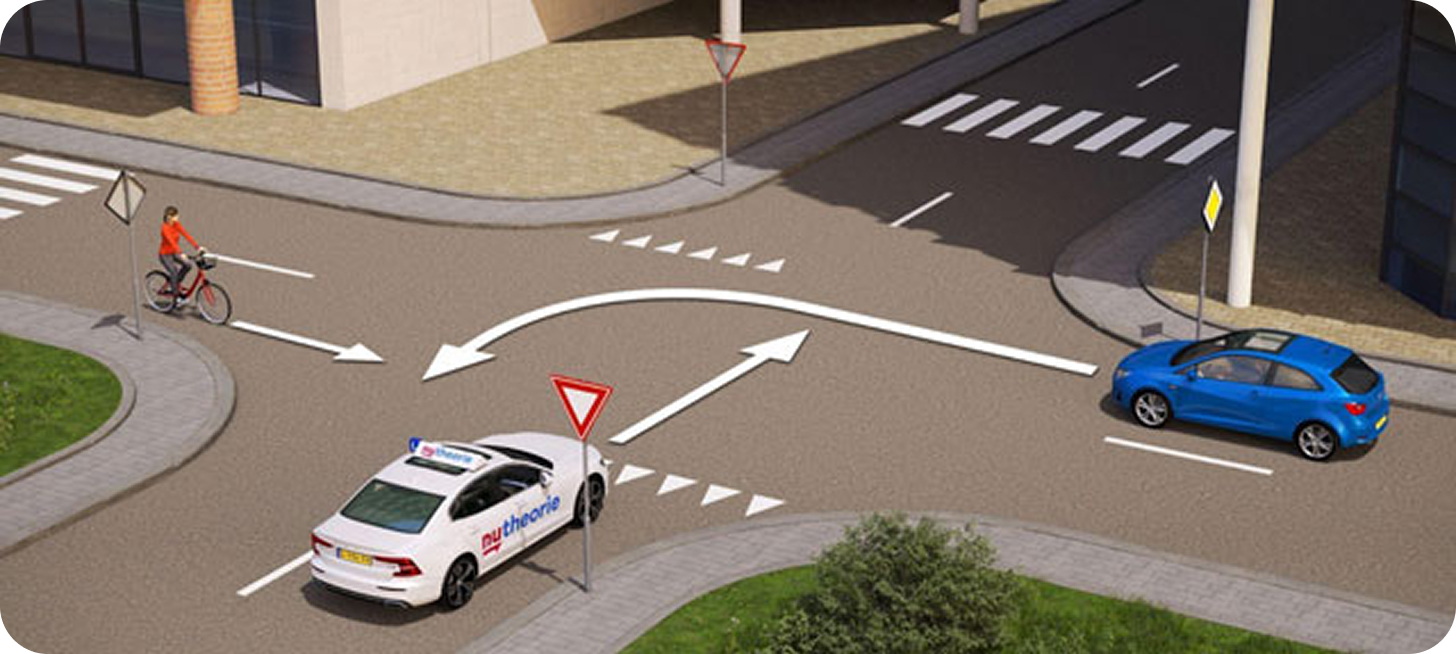Right of way rules
In general, you can follow a step-by-step plan for every situation to know who must give way and when. This plan is as follows:
- First, look at traffic signs and road markings.
Are there yield lines, stop signs or priority signs visible? Then these determine who must give way. - No signs or markings? Then: right has the right of way.
If there are no markings or signs, drivers from the right have the right of way - Traffic on the same road
Are both drivers already on the same road? Then:- Straight ahead on the same road goes before turning traffic
- Short turn goes before long turn
(For example: a driver turning right goes before someone turning left)
First, look at what the signs and markings on the road say about the right of way. These always take precedence.
Note: signs and markings apply only to drivers and not to pedestrians.
If there are no signs or markings, you are dealing with an equal intersection. If you and your oncoming vehicle have the same signs or markings, they cancel each other out and then again: drivers from the right have the right of way. This also does not apply to pedestrians. If no one or multiple drivers are coming from the right, then look at what the traffic intends to do. For traffic on the same road, drivers going straight have priority over those turning. If multiple drivers want to turn, the one making the short turn goes before the one making the long turn.
Example situation: right of way rules
We will discuss the following situation as an example so you can see how to apply the right of way rules. Look at the image below and try to see who may go first. Do you know?

First, look at what the signs and markings on the road say about the right of way. Then you see that the driving school car has yield lines and the accompanying yield sign. The blue car and the cyclist are on a priority road. You can already conclude that the driving school car goes last. Because the signs and markings on the road do not show whether the cyclist or the blue car goes first, you move to step two: drivers from the right have priority.
In this case, neither is coming from the right and both are on the same road. Therefore, go to step three: straight ahead on the same road goes before or if both are turning; the short turn goes before the long turn. In this case, the cyclist goes straight on the same road and the blue car wants to turn left. So the blue car must give way to the cyclist.
The correct order of right of way in this traffic situation is:
- Cyclist
- Blue car
- Driving school car
Right of way rules at an exit
What are the right of way rules at an exit? When leaving an exit, you must give way to all road users. All road users include both drivers and pedestrians. An exit is recognized by the exit construction, usually a lowered curb. You often encounter this when leaving a residential area. If a residential area does not end with an exit, then the normal right of way rules apply.
So do not focus on the sign indicating that you are leaving a residential area, but on the exit construction. When two cars cannot pass each other in a narrow exit, the rule is: out first, then in.
Right of way rules on an unpaved road
An unpaved road is usually recognizable as a dirt road. An unpaved road is a road not paved with stones or asphalt.
If you are coming from an unpaved road, you must give way to all drivers.
Note: at an exit you must give way to all road users, but from an unpaved road, you only give way to all drivers.
Right of way on a roundabout
In principle, drivers from the right have the right of way on a roundabout, but in practice there are almost always yield lines on the roundabout. Drivers already on the roundabout then have the right of way over those who want to enter. Also, when leaving a roundabout, you must give way to traffic, usually cyclists or pedestrians, that is on the roundabout.
There is a difference between a cycle lane that lies on the roundabout and a cycle path that runs next to it. In the latter case, unless otherwise indicated, you do not have to give way to cyclists when leaving the roundabout.







